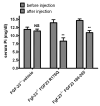Biological activity of FGF-23 fragments
- PMID: 17333246
- PMCID: PMC3818792
- DOI: 10.1007/s00424-007-0231-5
Biological activity of FGF-23 fragments
Abstract
The phosphaturic activity of intact, full-length, fibroblast growth factor-23 (FGF-23) is well documented. FGF-23 circulates as the intact protein and as fragments generated as the result of proteolysis of the full-length protein. To assess whether short fragments of FGF-23 are phosphaturic, we compared the effect of acute, equimolar infusions of full-length FGF-23 and various FGF-23 fragments carboxyl-terminal to amino acid 176. In rats, intravenous infusions of full-length FGF-23 and FGF-23 176-251 significantly and equivalently increased fractional phosphate excretion (FE Pi) from 14 +/- 3 to 32 +/- 5% and 15 +/- 2 to 33 +/- 2% (p < 0.001), respectively. Chronic administration of FGF-23 176-251 reduced serum Pi and serum concentrations of 1alpha,25-dihydroxyvitamin D. Shorter forms of FGF-23 (FGF-23 180-251 and FGF-23 184-251) retained phosphaturic activity. Further shortening of the FGF-23 carboxyl-terminal domain, however, abolished phosphaturic activity, as infusion of FGF-23 206-251 did not increase urinary phosphate excretion. Infusion of a short fragment of the FGF-23 molecule, FGF-23 180-205, significantly increased FE Pi in rats and reduced serum Pi in hyperphosphatemic Fgf-23 ( -/- ) knockout mice. The activity of FGF-23 180-251 was confirmed in opossum kidney cells in which the peptide reduced Na(+)-dependent Pi uptake and enhanced internalization of the Na(+)-Pi IIa co-transporter. We conclude that carboxyl terminal fragments of FGF-23 are phosphaturic and that a short, 26-amino acid fragment of FGF-23 retains significant phosphaturic activity.
Figures





References
-
- Cancilla B, Davies A, Cauchi JA, Risbridger GP, Bertram JF. Fibroblast growth factor receptors and their ligands in the adult rat kidney. Kidney Int. 2001;60:147–155. - PubMed
-
- Cancilla B, Ford-Perriss MD, Bertram JF. Expression and localization of fibroblast growth factors and fibroblast growth factor receptors in the developing rat kidney. Kidney Int. 1999;56:2025–2039. - PubMed
-
- Steiling H, Werner S. Fibroblast growth factors: key players in epithelial morphogenesis, repair and cytoprotection. Curr Opin Biotechnol. 2003;14:533–537. - PubMed
-
- Eswarakumar VP, Lax I, Schlessinger J. Cellular signaling by fibroblast growth factor receptors. Cytokine Growth Factor Rev. 2005;16:139–149. - PubMed
Publication types
MeSH terms
Substances
Grants and funding
LinkOut - more resources
Full Text Sources
Other Literature Sources
Research Materials
Miscellaneous

